
The Polar Satellite Launch Vehicle (PSLV) is an expendable medium-lift launch vehicle designed and operated by the Indian Space Research Organisation (ISRO). It was developed to allow India to launch its Indian Remote Sensing (IRS) satellites into Sun-synchronous orbits, a service that was, until the advent of the PSLV in 1993, only commercially available from Russia. PSLV can also launch small size satellites into Geostationary Transfer Orbit (GTO).

Cartosat-1 is a stereoscopic Earth observation satellite in a Sun-synchronous orbit, and the first one of the Cartosat series of satellites. The eleventh satellite of ISRO in Indian Remote Sensing Satellite (IRS) series. The satellite was launched by Indian Space Research Organisation and is operated by NTRO. Weighing around 1560 kg at launch, its applications will mainly be towards cartography in India.
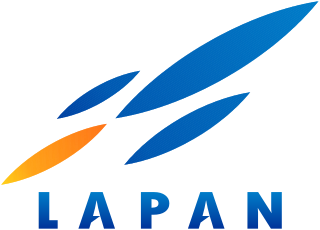
The National Institute of Aeronautics and Space was the Indonesian government's space agency. It was established on 27 November 1963, by former Indonesian president Sukarno, after one year's existence of a previous, informal space agency organization. LAPAN is responsible for long-term civilian and military aerospace research.
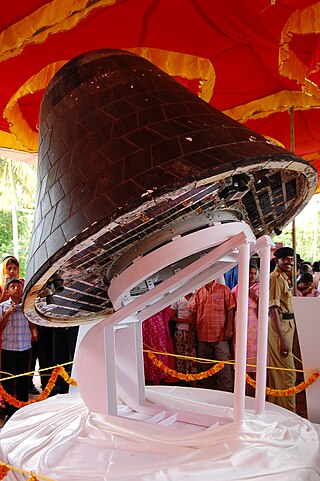
The Space Capsule Recovery Experiment is an Indian experimental spacecraft which was launched at 03:53 UTC on January 10, 2007, from Sriharikota by the Indian Space Research Organisation (ISRO). The launch was conducted using the C7 launch of the PSLV rocket, along with three other satellites. It remained in orbit for 12 days before re-entering the Earth's atmosphere and splashing down into the Bay of Bengal at 04:16 UTC on January 22.
Cartosat-2 was an Earth observation satellite in a Sun-synchronous orbit and the second of the Cartosat series of satellites. The satellite was built, launched and maintained by the Indian Space Research Organisation (ISRO). Weighing around 680 kg at launch, its applications were mainly be towards cartography. It was launched by the Polar Satellite Launch Vehicle PSLV C7 launch vehicle on 10 January 2007.
The Cartosat is a series of Indian optical Earth observation satellites built and operated by the Indian Space Research Organisation (ISRO). The Cartosat series is a part of the Indian Remote Sensing Program. They are used for Earth's resource management, defence services and monitoring.
PSLV-C34 was the 36th mission of the PSLV program and 14th mission of PSLV in XL configuration. The PSLV-C34 successfully carried and deployed 20 satellites in the Sun-synchronous orbit. With a launch mass of 320,000 kilograms (710,000 lb) and payload mass of 1,288 kilograms (2,840 lb), the C34 set a new record of deploying the maximum number of satellites by Indian Space Research Organisation in a single mission. The PSLV-C34 carried One Cartosat-2 satellite, SathyabamaSat, Swayam & 17 other satellites from United States, Canada, Germany & Indonesia.
PSLV-C2 was the second operational launch and overall fifth mission of the Polar Satellite Launch Vehicle (PSLV) program. This launch was also the forty-third launch by Indian Space Research Organisation (ISRO) since its first mission on 1 January 1962. The vehicle carried three satellites which were deployed in the Sun-synchronous low Earth orbit. The vehicle carried India's first remote sensing satellite Oceansat-1 (IRS-P4) as the main payload. It also carried South Korean satellite KITSAT-3 and German satellite DLR-Tubsat as auxiliary payloads. PSLV-C2 was the first Indian Expendable launch vehicle to carry and deploy more than one satellite in a mission. This was also India's and ISRO's first commercial spaceflight where South Korea and Germany each paid US$1.0 million to ISRO for launching their satellites.

PSLV-C6 was the sixth operational launch and overall ninth mission of the PSLV program. This launch was also the fifty-fourth launch by Indian Space Research Organisation since its first mission on 1 January 1962. The vehicle carried and injected India's two satellites; Cartosat-1 and HAMSAT into the Sun-synchronous orbit. PSLV-C6 was launched at 04:44 hours Coordinated Universal Time on 5 May 2005 from the second launch pad of the Satish Dhawan Space Centre.

PSLV-C37 was the 39th mission of the Indian Polar Satellite Launch Vehicle (PSLV) program and its 16th mission in the XL configuration undertaken by the Indian Space Research Organisation (ISRO). Launched on 15 February 2017 from the Satish Dhawan Space Centre at Sriharikota, Andhra Pradesh, the rocket successfully carried and deployed a record number of 104 satellites in Sun-synchronous orbits in a single mission, breaking the earlier record of launching 37 satellites by a Russian Dnepr rocket on 19 June 2014. This record was held until the launch of the Transporter-1 mission by SpaceX on 24 January 2021 which launched 143 satellites.
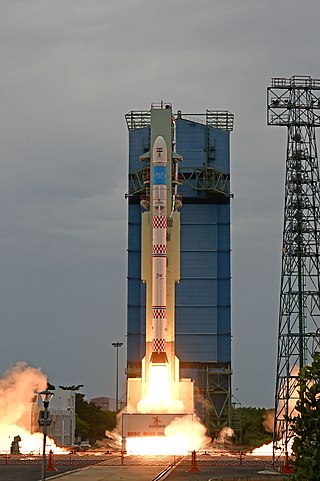
The Small Satellite Launch Vehicle (SSLV) is a small-lift launch vehicle developed by ISRO to deliver 500 kg (1,100 lb) payload to low Earth orbit or 300 kg (660 lb) payload to Sun-synchronous orbit. The rocket supports multi-orbital drop-offs capability for small satellites.

PSLV-C42 was the 44th mission of the Indian Polar Satellite Launch Vehicle (PSLV) program and its 12th mission in the Core Alone (CA) configuration. PSLV-C42 successfully carried and deployed 2 Earth observation satellites in Sun-synchronous orbits at an altitude of 588 kilometres (365 mi). It was launched on 16 September 2018 by the Indian Space Research Organisation (ISRO) from the first launch pad of the Satish Dhawan Space Centre at Sriharikota, Andhra Pradesh. The two international satellites were launched as part of a commercial arrangement between Surrey Satellite Technology Limited (SSTL) and ISRO's commercial arm Antrix Corporation Limited, run under the auspices of the Indian Government's Department of Space.

The PSLV-C44 was the 46th mission of the Indian Polar Satellite Launch Vehicle (PSLV) program. It was the first flight of PSLV-DL, having 2 strap-on boosters and placed a primary payload Microsat-R and a secondary payload of Kalamsat V2 in Sun-synchronous orbits.

RISAT-2BR1 is a synthetic-aperture radar (SAR) imaging satellite built by Indian Space Research Organisation (ISRO). It is part of India's RISAT series of SAR imaging satellite and fourth satellite in the series. RISAT-2BR1 was launched on 11 December 2019 at 09:55 UTC aboard Polar Satellite Launch Vehicle PSLV-C48 from First Launch Pad (FLP) of Satish Dhawan Space Centre. It was the 50th launch of Polar Satellite Launch Vehicle and 75th launch from Satish Dhawan Space Centre.
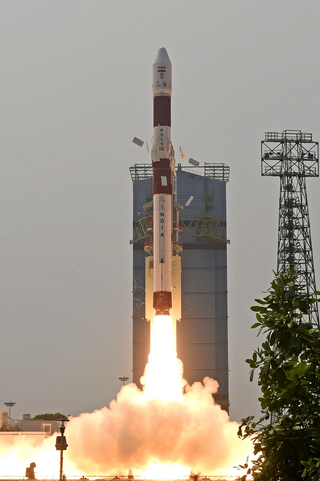
The PSLV-C55 was the 57th mission of Indian Space Research Organisation's Polar Satellite Launch Vehicle (PSLV) and the 16th flight of the PSLV-CA variant.

PSLV-C41 was the 43rd mission of the Indian Polar Satellite Launch Vehicle (PSLV) rocket. It was launched on Thursday, April 12, 2018, at 04:04 Hrs (IST) by the Indian Space Research Organisation (ISRO) from the first launch pad of the Satish Dhawan Space Centre at Sriharikota, Andhra Pradesh. This was the 12th mission to use the PSLV XL configuration.

PSLV-C46 was a mission of the Indian Polar Satellite Launch Vehicle (PSLV) rocket, launched on Thursday, May 22, 2019, at 05:30 Hrs (IST) by the Indian Space Research Organisation (ISRO) from the first launch pad of the Satish Dhawan Space Centre at Sriharikota, Andhra Pradesh. In this mission, the 'Core-Alone' configuration of PSLV was flown.

PSLV-C47 was a mission of the Indian Polar Satellite Launch Vehicle (PSLV) rocket, launched on Thursday, November 27, 2019, at 09:27 Hrs (IST) by the Indian Space Research Organisation (ISRO) from the second launch pad of the Satish Dhawan Space Centre at Sriharikota, Andhra Pradesh.
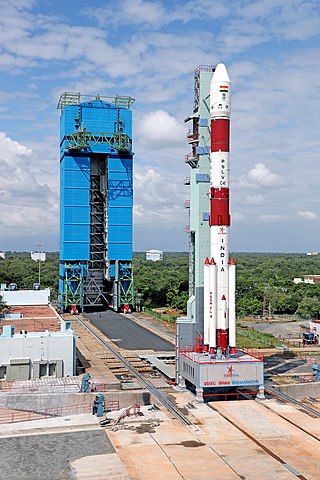
PSLV-C48 was a mission of the Indian Polar Satellite Launch Vehicle (PSLV) rocket, launched on Thursday, December 11, 2019, at 15:25 Hrs (IST) by the Indian Space Research Organisation (ISRO) from the second launch pad of the Satish Dhawan Space Centre at Sriharikota, Andhra Pradesh.



















